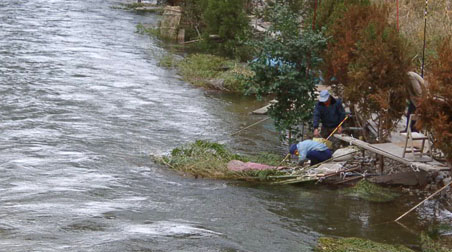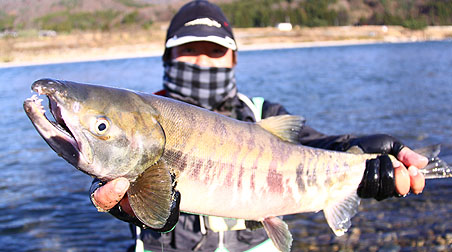Salmon
Salmon and Murakami
Anyone exploring Murakami is bound to come across salmon in one form or another. The fish appears in colorful imagery along the streets, and numerous restaurants serve a wide variety of salmon dishes. Even more conspicuous are the rows of large salmon hung out to dry under the eaves of houses and shops throughout the city, reminders of a culinary-cultural heritage that goes back centuries.
The foremost of fish
Salmon teeth found in the remains of prehistoric dwellings suggest that the fish has been part of the local diet for more than four thousand years. Records show that salmon from Echigo Province (present-day Niigata Prefecture) was presented to the court in Kyoto in the tenth century. In the seventeenth century, taxes levied on salmon fishermen were an important source of income for the Murakami domain. However, Murakami’s special relationship with salmon can be traced to one particularly perceptive samurai who lived in the mid-1700s.
Chum salmon (Oncorhynchus keta), best known for its large orange roe, is the predominant salmon species in the seas off Murakami. Chum salmon are born in rivers, then migrate to the Sea of Okhotsk, the North Pacific, and the Bering Sea where they mature for around four years before returning to their home grounds to spawn once before they die. In Murakami, salmon migrate up the Miomote River between October and December each year. The first person to understand this cycle was Aoto Buheiji (1713–1788), who established the world’s first salmon hatchery in Murakami.
Buheiji, as he was known, was charged with managing the waterways of the Murakami domain, whose tax revenue from salmon fishing had almost completely dried up in the early 1700s due to decades of overfishing. Armed with the insight that protecting spawning fish, eggs, and fry in the river would ensure a stable population of adult salmon returning in the autumn and winter, he had a narrow waterway dug next to the main branch of the Miomote River. Returning salmon were directed to spawn in the canal, where their eggs could be kept safe until hatching in spring, and fishing was restricted to the main river.
Buheiji’s efforts allowed salmon stocks to recover and the Murakami domain to prosper. Salmon assumed a starring role in local culinary culture, a position it retains to this day.

A dried delicacy
The people of Murakami eat salmon on seasonal and celebratory occasions as well as in daily life. Among the more than 100 ways that salmon is prepared in the city, shiobiki and sakabitashi are two of the most prominent. Both involve hanging the fish out to dry in the cold winter air.
Salmon caught late in the year are cleaned, layered with salt, and left to sit for about a week. The fish are then washed and suspended by their tails so they will not look like they are hanging from a noose. Similarly, their bellies are not cut completely open, which might evoke seppuku, the ritual disembowelment committed by disgraced samurai.
For shiobiki, the fish are taken down after being aged like this for around two weeks. Grilled shiobiki salmon is lean with a smooth texture and gently savory flavor. For sakabitashi, the drying process takes six to twelve months, resulting in meat with a concentrated flavor and jerky-like texture. Sakabitashi salmon is eaten in thin slices sprinkled with sake or mirin. Other popular recipes include fermented salmon organs, reflecting the commitment to let no part of the fish go to waste, and salmon wrapped in tender kombu kelp and boiled in soy sauce, sake, and sugar.
Learn more
Displays at the Iyoboya Kaikan salmon museum in central Murakami explain the ecology of salmon and its place in local culture. Visitors can also observe live salmon and other fish, some of which are in the waterway dug by Aoto Buheiji, which remains in use as a hatchery today.

Iyoboya Kaikan (salmon museum)
Going down to the basement floor of the kaikan(museum), there are glass walls in front of you, and through which you can enjoy the inside view of Miomote river's branch. From fall through winter, salmon swimming up the river can be seen.

Iyoboya Kaikan
add: 13-34 Shiomachi Murakami-shi >> map
You can observe traditional salmon fishing.
When salmon starts to come back. You can see the traditional fishing method "Iguriamiryo" using river boats in Miomote river.
From mid October to November 30th from 9:00
add: Hagegafuchi Murakami-shi (Miomote river Salmon Fishery Association Third Hatchery) >> map

Iguriamiryo

Ookawa river Kodoryo





